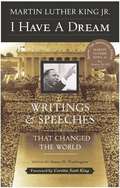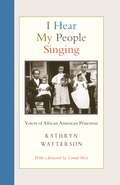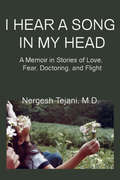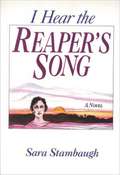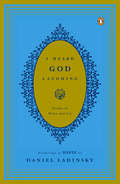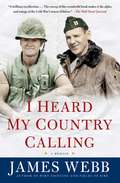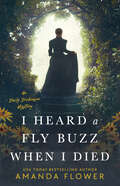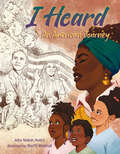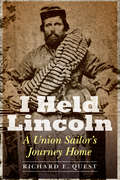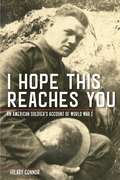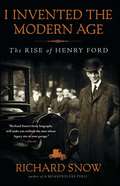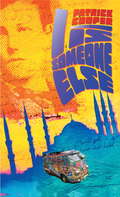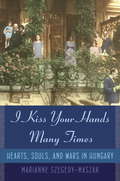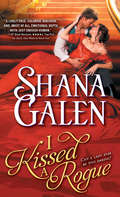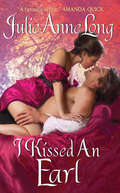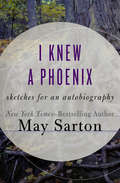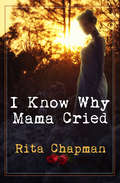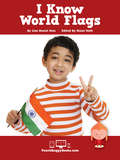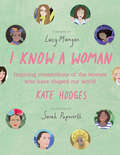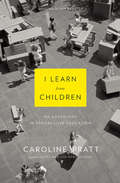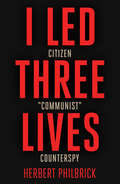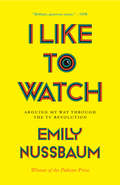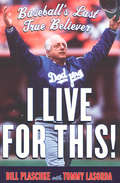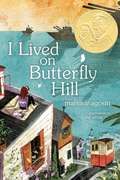- Table View
- List View
I Have a Dream: Writings and Speeches that Changed the World
by James Melvin Washington Martin Luther King Jr.A concise and convenient presentation of the most memorable writings and speeches of Dr. Martin Luther King Jr. Foreword by Coretta Scott King.
I Hear My People Singing: Voices of African American Princeton
by Kathryn WattersonA vivid history of life in Princeton, New Jersey, told through the voices of its African American residentsI Hear My People Singing shines a light on a small but historic black neighborhood at the heart of one of the most elite and world-renowned Ivy-League towns—Princeton, New Jersey. The vivid first-person accounts of more than fifty black residents detail aspects of their lives throughout the twentieth century. Their stories show that the roots of Princeton’s African American community are as deeply intertwined with the town and university as they are with the history of the United States, the legacies of slavery, and the nation’s current conversations on race.Drawn from an oral history collaboration with residents of the Witherspoon-Jackson neighborhood, Princeton undergraduates, and their professor, Kathryn Watterson, neighbors speak candidly about Jim Crow segregation, the consequences of school integration, World Wars I and II, and the struggles for equal opportunities and civil rights. Despite three centuries of legal and economic obstacles, African American residents have created a flourishing, ethical, and humane neighborhood in which to raise their children, care for the sick and elderly, worship, stand their ground, and celebrate life. Abundantly filled with photographs, I Hear My People Singing personalizes the injustices faced by generations of black Princetonians—including the famed Paul Robeson—and highlights the community’s remarkable achievements. The introductions to each chapter provide historical context, as does the book’s foreword by noted scholar, theologian, and activist Cornel West.An intimate testament of the black community’s resilience and ingenuity, I Hear My People Singing adds a never-before-compiled account of poignant black experience to an American narrative that needs to be heard now more than ever.
I Hear a Song in My Head: A Memoir in Stories of Love, Fear, Doctoring, and Flight
by M.D. Nergesh Tejani“[Tejani] shares her stories of succeeding as a doctor in Uganda during the 1960s . . . a must for those seeking a medical memoir collection.” —Midwest Book ReviewSet in Uganda of the sixties with bookends in India and New York, this doctor’s story tells of a turbulent political time when colonial Uganda graduated to self-rule. It is also the personal story of an Indian woman living in an independent African country wanting and needing assimilation but regretfully recognizing rejection. It is the story of the exhilaration of living in a country more beautiful than Eden, if sometimes a threatened Eden. But most of all it tells doctoring tales made delicate by seeing them through the heart. It was a time in medicine before evidential imperatives removed the romance. “Dr. Tejani’s unique meld of skill and compassion radiates throughout this text which will touch both physician and lay readers alike.” —Frank A. Chervenak, MD, New York Weill Cornell Medical Center “With clarity, drama, and humor, this book creates a family story, a picture of an African nation in the throes of political upheaval, and an original and illuminating view of medical needs and practices in circumstances that exist today in many parts of the world. The complex harmonies of the song in Dr. Tejani’s head will resonate for a wide variety of readers.” —Carol Sicherman, author of Rude Awakenings“Nergesh Tejani is a terrific writer . . . Her subject is often exotic, often with international themes and full of pithy observations and wisdom.” —Abraham Verghese, MD, Professor of the Theory and Practice of Medicine, Stanford University Medical Center
I Hear the Reaper's Song: A Novel
by Sara StambaughSet in a small Mennonite community in Pennsylvania in 1896, this novel depicts the reaction of the "plain people" to various modern encroachments. Publishers Weekly called it, "A beautifully told lesson for the contemporary reader in how any community adapts to a changing world." Portrays tragedy and crisis in a small Pennsylvania community in 1896 from the point of view of a 15-year-old Mennonite boy in the whirlpool of his first encounter with death. In the spring of 1896, Silas Hershey was 15. He worked hard six days a week alongside his family in their corn and tobacco fields. On Sundays he gossiped with his cousin Sam, eyeing the girls from a corner of the Paradise Mennonite Church yard, and several evenings a week he drove his sister Barbie and cousin Biney to "special meetings" at nearby churches. Then there were the troubled romances of both Barbie and older brother Hen. But social and political change was flooding the country, and in Lancaster County, Pennsylvania, the ripples lapped up over the church steps and into the pulpits. The special evening meetings which to Silas and Sam were little more than out-of-the-ordinary social occasions in fact signalled a radical change in Mennonite belief and tradition. All promoted by the "Western preachers," as Silas called them. Events come to a climax one summer Saturday night when Barbie and her young man, Enos Barge, are coming home from a party and a train hits their buggy at a dangerous crossing. The Western preachers capitalize on the incident; neither Barbie nor Enos had yet joined church, and the revivalists point to them as examples of what can happen to those who are not "saved." People convert in flocks. And the Hersheys, to whom Barbie was their light and joy, are left stunned by grief, struggling to keep a shattered family from disintegrating. Sara Stambaugh tells the story with both sympathy and candor. She also succeeds remarkably well in capturing the point of view, language, and feelings of an adolescent Mennonite boy, caught in the whirlpool of a first encounter with death. Her images evoke a time and place so clearly that the reader can almost smell the arbutus and feel the crackle of ice underfoot.Skyhorse Publishing, as well as our Arcade, Yucca, and Good Books imprints, are proud to publish a broad range of books for readers interested in fiction-novels, novellas, political and medical thrillers, comedy, satire, historical fiction, romance, erotic and love stories, mystery, classic literature, folklore and mythology, literary classics including Shakespeare, Dumas, Wilde, Cather, and much more. While not every title we publish becomes a New York Times bestseller or a national bestseller, we are committed to books on subjects that are sometimes overlooked and to authors whose work might not otherwise find a home.
I Heard God Laughing: Poems of Hope and Joy
by HafizFrom the renowned translator of The Gift, a rich collection that brings the great Sufi poet to Western readers To Persians , the poems of Hafiz are not "classical literature" from a remote past but cherished wisdom from a dear and intimate friend that continue to be quoted in daily life. With uncanny insight, Hafiz captures the many forms and stages of love. His poetry outlines the stages of the mystic's "path of love"-a journey in which love dissolves personal boundaries and limitations to join larger processes of growth and transformation. With this stunning collection, Ladinsky has succeeded brilliantly in translating the essence of one of Islam's greatest poetic and spiritual voices. BACKCOVER: "If you haven't yet had the delight of dining with Daniel Ladinsky's sweet, playful renderings of the musings of the great saints, I Heard God Laughing is a perfect appetizer. . . . This newly released edition of his first playful foray into Hafiz's divinely inspired poetry is essential reading . . . . Ladinsky is a master who will be remembered for finally bringing Hafiz alive in the West. " -Alexandra Marks, The Christian Science Monitor .
I Heard It Through the Grapevine: Rumor in African-American Culture
by Patricia A. TurnerI Heard It Through the Grapevine explores how rumors that run rife in African-American communities, concerning such issues as AIDS, the Ku Klux Klan and FBI conspiracies, translate white oppression into folk warnings, and are used by the community to respond to a hostile dominant culture.
I Heard My Country Calling: A Memoir
by James WebbIn this brilliantly received memoir, former senator James Webb has outdone himself. It is rare in America that one individual is recognized for the highest levels of combat valor, as a respected member of the literary and journalistic world, and as a blunt-spoken leader in national politics. In this extraordinary memoir, Webb writes vividly about the early years that shaped such a remarkable personal journey.Webb’s mother grew up in the poverty-stricken cotton fields of East Arkansas. His father and lifetime hero was the first in many generations of Webbs, whose roots are in Appalachia, to finish high school. He flew bombers in World War II and cargo planes in the Berlin Airlift, graduated from college in middle age, and became an expert in the nation’s most advanced weaponry. Webb’s account of his childhood is a tremendous American saga as the family endures the constant moves and challenges of the rarely examined post–World War II military, with a stern but emotionally invested father, a loving mother who had borne four children by the age of twenty-four, a granite-like grandmother who held the family together during his father’s frequent deployments, and a rich assortment of aunts, siblings, and cousins. Webb tells of his four years at Annapolis in a voice that is painfully honest but in the end triumphant. His description of Vietnam’s most brutal battlefields breaks new literary ground. One of the most highly decorated combat Marines of that war, he is a respected expert on the history and conduct of the war. Webb’s novelist’s eyes and ears invest this work with remarkable power, whether he is describing the resiliency that grew from constant relocations during his childhood, the longing for his absent father, his poignant good-bye to his parents as he leaves for Vietnam, his role as a twenty-three-year-old lieutenant through months of constant combat, or his election to the Senate, where he was a leader on national defense, foreign policy, and economic fairness. This is a life that could happen only in America.
I Heard a Fly Buzz When I Died (An Emily Dickinson Mystery #2)
by Amanda FlowerWhen a literary icon stays with the Dickinson family, Emily and her housemaid Willa find themselves embroiled in a shocking murder in this new mystery from USA Today bestselling and Agatha Award–winning author Amanda Flower.August 1856. The Dickinson family is comfortably settled in their homestead on Main Street. Emily&’s brother, Austin Dickinson, and his new wife are delighted when famous thinker and writer Ralph Waldo Emerson comes to Amherst to speak at a local literary society and decides he and his young secretary, Luther Howard, will stay with the newlyweds. Emily has been a longtime admirer of Emerson&’s writing and is thrilled at the chance to meet her idol. She is determined to impress him with her quick wit, and if she can gather the courage, a poem. Willa Noble, the second maid in the Dickinson home and Emily's friend, encourages her to speak to the famous but stern man. But his secretary, Luther, intrigues Willa more because of his clear fondness for the Dickinson sisters.Willa does not know if Luther truly cares for one of the Dickinson girls or if he just sees marrying one of them as a way to raise himself up in society. After a few days in his company, Willa starts to believe it&’s the latter. Miss Lavinia, Emily&’s sister, appears to be enchanted by Luther; a fact that bothers Emily greatly. However, Emily&’s fears are squashed when Luther turns up dead in the Dickinson&’s garden. It seems that he was poisoned. Emerson, aghast at the death of his secretary, demands answers. Emily and Willa set out to find them in order to save the Dickinson family reputation and stop a cold-blooded fiend from killing again.
I Heard: An American Journey
by Jaha Nailah AveryA powerful and poetic picture book about Black history in the United States, from the shores of Africa and slavery, to the civil rights and Black Lives Matter movements.With stunning lyricism reminiscent of traditional African spirituals and today's rhythm and flow of hip-hop, a teacher shares the history of being Black in the US, while continuing to march into present day--undeterred and proud to be Black. Author Jaha Nailah Avery shows you have to understand the past to shape the future, and knowing who you are gives you the strength to do just that.The book's back matter on Black history is an extensive resource and provides additional context to the reading of I Heard.
I Held Lincoln: A Union Sailor's Journey Home
by Richard E. QuestLt. Benjamin Loring (1824–1902) lived the life of an everyman Civil War sailor. He commanded no armies and devised no grand strategies. Loring was a sailor who just wanted to return home, where the biggest story of his life awaited him. Covering almost a year of Loring’s service, I Held Lincoln describes the lieutenant’s command of the gunboat USS Wave, the Battle of Calcasieu Pass, the surrender of his ship, and his capture by the Confederates. He was incarcerated in Camp Groce, a deadly Confederate prison where he endured horrific conditions and abuse. Loring attempted to escape, evading capture for ten days behind enemy lines, only to be recaptured just a few miles from freedom. After an arduous second escape, he finally reached the safety of Union lines and gained his freedom. On the night of April 14, 1865, Loring attended Ford’s Theater and witnessed one of the single most tragic events in American history: the assassination of President Abraham Lincoln. After the shot rang out, Loring climbed into the presidential box and assisted the dying president, helping to carry him across the street to the Peterson House. Using Loring’s recently discovered private journal, Richard E. Quest tells this astonishing now-recovered story, giving insight into a little-known Confederate prison camp during the last days of the Civil War and providing much-deserved recognition to a man whose journey was nearly lost to American history.
I Hope This Reaches You: An American Soldier’s Account of World War I (Great Lakes Books Series)
by Hilary ConnorI Hope This Reaches You: An American Soldier’s Account of World War I begins in May 1917 with Byron Fiske Field (1897–1968) boarding a morning train bound for Detroit with one objective in mind: to help the United States win the war against Germany. A pacifist at heart, Field had just finished his freshman year at Albion College where he was studying to be a Methodist missionary. Although he found the idea of killing another human to be at odds with his Christian beliefs, like other Americans he was convinced of the righteousness of World War I—the war to end all wars—and he was determined to do his part. In recounting Field’s story, Hilary Connor relied on four principal sources of information found in a footlocker issued to Field as a member of the 168th Ambulance Company in the 42nd Division—or as it was more famously known, the Rainbow Division. The first of these sources is a handwritten diary kept by Byron from February 1918 to July 1919. The second cache of firsthand information is contained in two books that were co-authored by Field and other select Company members in the late winter and early spring of 1919, recounting events and personal experiences of the war—The History of Ambulance Company 168 and Iodine and Gasoline. The third and perhaps most extraordinary source is a collection of over three hundred letters written by Field during the war to his parents and college girlfriend. Included in many of the letters are mementos ranging from the petals of regional flowers in bloom to Red Cross notices to church service programs and other pieces of everyday life that proved invaluable in helping to create a broader and richer historical context. The last category of material is a voluminous collection of personal papers, including academic articles, speech notes, and opinion pieces, written by Field in the decades following the war. The breadth of materials is only further enhanced by the benefit of one hundred years hindsight, lending itself to a more thorough understanding of many of the momentous events that occurred during those years. I Hope This Reaches You is a tapestry of human experience woven from the narrative threads of love, loss, loyalty, sacrifice, triumph, and tragedy that will call to any reader of historical memoirs.
I Invented the Modern Age: The Rise of Henry Ford
by Richard SnowFrom the acclaimed popular historian Richard Snow, who “writes with verve and a keen eye” (The New York Times Book Review), comes a fresh and entertaining account of Henry Ford and his invention of the Model T—the ugly, cranky, invincible machine that defined twentieth-century America. Every century or so, our republic has been remade by a new technology: 170 years ago the railroad changed Americans’ conception of space and time; in our era, the microprocessor revolutionized how humans communicate. But in the early twentieth century the agent of creative destruction was the gasoline engine, as put to work by an unknown and relentlessly industrious young man named Henry Ford. Born the same year as the battle of Gettysburg, Ford died two years after the atomic bombs fell, and his life personified the tremendous technological changes achieved in that span. Growing up as a Michigan farm boy with a bone-deep loathing of farming, Ford intuitively saw the advantages of internal combustion. Resourceful and fearless, he built his first gasoline engine out of scavenged industrial scraps. It was the size of a sewing machine. From there, scene by scene, Richard Snow vividly shows Ford using his innate mechanical abilities, hard work, and radical imagination as he transformed American industry. In many ways, of course, Ford’s story is well known; in many more ways, it is not. Richard Snow masterfully weaves together a fascinating narrative of Ford’s rise to fame through his greatest invention, the Model T. When Ford first unveiled this car, it took twelve and a half hours to build one. A little more than a decade later, it took exactly one minute. In making his car so quickly and so cheaply that his own workers could easily afford it, Ford created the cycle of consumerism that we still inhabit. Our country changed in a mere decade, and Ford became a national hero. But then he soured, and the benevolent side of his character went into an ever-deepening eclipse, even as the America he had remade evolved beyond all imagining into a global power capable of producing on a vast scale not only cars, but airplanes, ships, machinery, and an infinity of household devices. A highly pleasurable read, filled with scenes and incidents from Ford’s life, particularly during the intense phase of his secretive competition with other early car manufacturers, I Invented the Modern Age shows Richard Snow at the height of his powers as a popular historian and reclaims from history Henry Ford, the remarkable man who, indeed, invented the modern world as we know it.
I Is Someone Else
by Patrick CooperIt is 1966, and the times, they are a-changin'. Fifteen-year-old Stephen is on his way to a summer program in France when he meets two glamorous new friends of his older brother, Rob, who has been missing for 18 months. They persuade Stephen to travel to Istanbul with them, to find his brother. And what a world opens up to him: a world of beautiful girls, drug busts, fascinating cultures, fast-moving friendships, and betrayals. As he travels further into Asia, the nature of Stephen's journey changes: The search for his brother is replaced by an inner exploration, in which he must confront his own past, and his own dark secret.
I Kiss Your Hands Many Times: Hearts, Souls, and Wars in Hungary
by Marianne Szegedy-MaszakA magnificent wartime love story about the forces that brought the author's parents together and those that nearly drove them apart Marianne Szegedy-Maszák's parents, Hanna and Aladár, met and fell in love in Budapest in 1940. He was a rising star in the foreign ministry--a vocal anti-Fascist who was in talks with the Allies when he was arrested and sent to Dachau. She was the granddaughter of Manfred Weiss, the industrialist patriarch of an aristocratic Jewish family that owned factories, were patrons of intellectuals and artists, and entertained dignitaries at their baronial estates. Though many in the family had converted to Catholicism decades earlier, when the Germans invaded Hungary in March 1944, they were forced into hiding. In a secret and controversial deal brokered with Heinrich Himmler, the family turned over their vast holdings in exchange for their safe passage to Portugal. Aladár survived Dachau, a fragile and anxious version of himself. After nearly two years without contact, he located Hanna and wrote her a letter that warned that he was not the man she'd last seen, but he was still in love with her. After months of waiting for visas and transit, she finally arrived in a devastated Budapest in December 1945, where at last they were wed. Framed by a cache of letters written between 1940 and 1947, Szegedy-Maszák's family memoir tells the story, at once intimate and epic, of the complicated relationship Hungary had with its Jewish population--the moments of glorious humanism that stood apart from its history of anti-Semitism--and with the rest of the world. She resurrects in riveting detail a lost world of splendor and carefully limns the moral struggles that history exacted--from a country and its individuals. Praise for I Kiss Your Hands Many Times "I Kiss Your Hand Many Times is the sweeping story of Marianne Szegedy-Maszák's family in pre- and post-World War II Europe, capturing the many ways the struggles of that period shaped her family for years to come. But most of all it is a beautiful love story, charting her parents' devotion in one of history's darkest hours."--Arianna Huffington, president and editor-in-chief, the Huffington Post Media Group "In this panoramic and gripping narrative of a vanished world of great wealth and power, Marianne Szegedy-Maszák restores an important missing chapter of European, Hungarian, and Holocaust history."--Kati Marton, author of Paris: A Love Story and Enemies of the People: My Family's Journey to America"How many times can a heart be broken? Hungarians know, Marianne Szegedy-Maszák's family more than most. History has broken theirs again and again. This is the story of that violence, told by the daughter of an extraordinary man and extraordinary woman who refused to surrender to it. Every perfectly chosen word is as it happened. So brace yourself. Truth can break hearts, too."--Robert Sam Anson, author of War News: A Young Reporter in Indochina"This family memoir is everything you could wish for in the genre: the story of a fascinating family that illuminates the historical time it lived through. . . . Informative and fascinating in every way, [I Kiss Your Hands Many Times] is a great introduction to World War II Hungary and a moving tale of personal relationships in a time of great duress."--Booklist (starred review)
I Kissed a Rogue
by Shana Galen"A perfectly delightful love story. This magical read is a keeper." -RT Book Reviews, Top Pick, 4 ½ stars for The Rogue You KnowOnce she spurned the man...When the Duke of Lennox hires Sir Brook Derring, England's best investigator, to find his daughter, Brook intends only to rescue the lady and return to his solitary life. He deals with London's roughest criminals every day of the week; surely he should be able to endure seeing his first love again-the perfect girl who broke his heart...Now her life depends on himLady Lillian-Anne Lennox has always done her best to live up to her father's standards of perfection-at the cost of following her heart. When she's kidnapped and her perfect life is shattered, Lila has another chance. Together, Lila and Brook navigate not only the dark and deadly side of London, but the chasm of pride and prejudice that divides them.
I Kissed an Earl: Pennyroyal Green Series (Pennyroyal Green #4)
by Julie Anne LongViolet Redmond's family and fortune might be formidable and her beauty and wit matchless--but her infamous flare for mischief keeps all but the most lionhearted suitors at bay. Only Violet knows what will assuage her restlessness: a man who doesn't bore her to tears, and a clue to the fate of her missing brother. She never dreamed she'd find both with a man whose own pedigree is far from impeccable. "Savage" is what the women of the ton whisper about the newly styled Earl of Ardmay--albeit with shivers of pleasure. Born an English bastard, raised on the high seas, he's on a mission to capture a notorious pirate for vengeance. But while Violet's belief in her brother's innocence maddens him, her courage awes him . . . and her sensuality finally undoes him. Now the man who once lost everything and the girl who has everything to lose are bound by a passion that could either end in betrayal . . . or become everything they ever dreamed.
I Knew a Phoenix: Sketches for an Autobiography
by May SartonMay Sarton&’s first memoir: A lyrical and enchanting look at her formative years from the onset of the First World War through the beginning of the Second Author of a dozen memoirs, May Sarton had a unique talent for capturing the wonder and beauty of nature, love, aging, and art. Throughout her prolific career, she penned many journals examining the different stages of her life, and in this, her first memoir, she laid the foundation for what would become one of the most beloved autobiographical oeuvres in modern literature. Sarton writes of her early childhood in Belgium in the years before World War I, her time in Boston while her father taught at Harvard, and her schooling in Cambridge, Massachusetts, where she fell in love with poetry and theater. She describes her first meetings and fast friendships with such notable figures as Virginia Woolf, Julian Huxley, James Stephens, and S. S. Koteliansky, many of whom would later come to populate her critically acclaimed journals. With sharp insights and captivating prose, I Knew a Phoenix introduces a generation of readers to one of the twentieth century&’s most cherished writers.
I Know Why Mama Cried (I Know Why Mama Cried Ser.)
by Rita Chapman&“An intense investigation into the shameful truths that often lie buried within the generations of a family . . . a masterfully prepared conclusion.&”—Dr. James F. Walter, author of Reading Marriage in the American Romance For years, Mims buries the horrid memory of a rape and her father&’s ultimate betrayal. When she becomes a wife and mother, her shame and guilt ignite with a latent anger to inspire gruesome thoughts of inflicting violence on her loved ones. One night, she stands beside her baby&’s crib, her rosary in one hand, and in the other, a ribbon with which she would strangle her baby. Will she succumb to the power of her anger, or will the God of her father and her church save her? &“Lyrical writing and an engaging plot make this elegant debut a must-read for everyone&’s list.&”—Amy Bourett, author of Mothers & Other Liars &“Compelling characters, a powerful story, and lyrical prose—Rita Chapman&’s stunning debut novel will linger in your heart and soul long after you reluctantly finish the last page. I Know Why MamaCried is a phenomenal book. Do not miss this reading experience.&”—Harry Hunsicker, author and former executive vice-president of Mystery Writers of America
I Know World Flags
by Lisa Daniel Rees Diane RathI Know World Flags is a fun informational picture eBook and introduction for five to twelve year olds to learn about flags from over 56 different countries. The book includes beautiful contextual photography of the flags and short descriptions in large print of the legends, myths and facts of how the flags came to be. I Know World Flags is a perfect introduction to geography and social studies for children and juvenile readers and is great for reference and activities.
I Know a Woman: Inspiring Connections of the Women Who Have Shaped Our World
by Kate HodgesBehind every great woman . . . is another great woman. Discover the connections between eighty-four female pioneers in art, politics, sports, aviation, science, and more . . . Threading tales from across the globe and throughout history, this inspiring book reveals the lives of innovative aviatrixes, gun-toting revolutionaries, extraordinary athletes, women with incomparable intellects, and more. Each woman is connected to the next, bringing to light the women behind the scenes—those who didn’t get the credit for scientific discoveries, sporting achievements, or acts of bravery in their lifetimes. Some names will be familiar, some might not, but all are equally important. With compelling storytelling and beautifully illustrated portraits, I Know a Woman is bold and engaging with a unique purpose: to uncover the links between eighty-four pioneering women and show the indomitable strength of womankind—through the stories of Michelle Obama, Virginia Woolf, Gala Dalí, Emma Watson, Nina Simone, Billie Jean King, Frida Kahlo, Marie Curie, Georgia O’Keeffe, Greta Garbo, Eleanor Roosevelt, Chimamanda Ngozi Adichie, Malala Yousafzai, and many more pioneering women who have shaped the world we live in today.
I Learn from Children: An Adventure in Progressive Education
by Caroline PrattA lucid presentation of what progressive education can accomplish.”The New York Times How should schools prepare students for the Information Age? The successful worker of the future a creative, independent thinker who works well in teams would seem to be too self-contradictory to be the deliberate product of a school. A century ago, the American educator Caroline Pratt created an innovative school that she hoped would produce such independent thinkers, but she asked herself a different question: Was it unreasonable to try to fit the school to the child, rather than . . . the child to the school?” A strong-willed, small-town schoolteacher who ran a one-room schoolhouse by the time she was seventeen, Pratt came to viscerally reject the teaching methods of her day, which often featured a long-winded teacher at the front of the room and rows of miserable children, on benches nailed to the floor, stretching to the back. In this classic 1948 memoir, now in its fourth edition, Pratt recounts, in a wry authorial voice much closer to Will Rogers than John Dewey, how she founded what is now the dynamic City and Country School in New York City; invented the maple unit blocks” that have become a staple in classrooms and children’s homes around the globe; and came to play an important role in reimagining preschool and primary-school education in ways that resound in the tumultuously creative age before us. This edition features a new introduction by Ian Frazier, as well as additional commentary, and an afterword.
I Led 3 Lives: Citizen, Communist, Counterspy
by Herbert A. PhilbrickI Led Three Lives: Citizen, Communist, Counterspy, first published in 1952, is a fascinating account of the author’s infiltration into the American Communist party in the 1940’s as a counterspy who then passed on his information to the FBI. Beginning as an advertising executive in Boston, Philbrick was inadvertently drawn into a front organization of the Communist Party. He was subsequently recruited by the U.S. Government to document Soviet efforts, operations and plans in the U.S.A. The book concludes with his testimony at the 1949 trial of the top eleven Communist Party-USA leaders. I Led Three Lives was a bestseller after its 1952 release, and was made into a popular television series of the same name. Included are five pages of illustrations.
I Like to Watch: Arguing My Way Through the TV Revolution
by Emily NussbaumFrom The New Yorker’s fiercely original, Pulitzer Prize-winning culture critic, a provocative collection of new and previously published essays arguing that we are what we watch.“Emily Nussbaum is the perfect critic—smart, engaging, funny, generous, and insightful.”—David Grann, author of Killers of the Flower Moon From her creation of the “Approval Matrix” in New York magazine in 2004 to her Pulitzer Prize–winning columns for The New Yorker, Emily Nussbaum has argued for a new way of looking at TV. In this collection, including two never-before-published essays, Nussbaum writes about her passion for television, beginning with Buffy the Vampire Slayer, the show that set her on a fresh intellectual path. She explores the rise of the female screw-up, how fans warp the shows they love, the messy power of sexual violence on TV, and the year that jokes helped elect a reality-television president. There are three big profiles of television showrunners—Kenya Barris, Jenji Kohan, and Ryan Murphy—as well as examinations of the legacies of Norman Lear and Joan Rivers. The book also includes a major new essay written during the year of #MeToo, wrestling with the question of what to do when the artist you love is a monster.More than a collection of reviews, the book makes a case for toppling the status anxiety that has long haunted the “idiot box,” even as it transformed. Through it all, Nussbaum recounts her fervent search, over fifteen years, for a new kind of criticism, one that resists the false hierarchy that elevates one kind of culture (violent, dramatic, gritty) over another (joyful, funny, stylized). I Like to Watch traces her own struggle to punch through stifling notions of “prestige television,” searching for a more expansive, more embracing vision of artistic ambition—one that acknowledges many types of beauty and complexity and opens to more varied voices. It’s a book that celebrates television as television, even as each year warps the definition of just what that might mean.Advance praise for I Like to Watch“This collection, including some powerful new work, proves once and for all that there’s no better American critic of anything than Emily Nussbaum. But I Like to Watch turns out to be even greater than the sum of its brilliant parts—it’s the most incisive, intimate, entertaining, authoritative guide to the shows of this golden television age.”—Kurt Andersen, author of Fantasyland“Reading Emily Nussbaum makes us smarter not just about what we watch, but about how we live, what we love, and who we are. I Like to Watch is a joy.”—Rebecca Traister
I Live for This!: Baseball's Last True Believer
by Bill Plaschke Tommy LasordaAn award-winning sportswriter teams up with LA Dodgers manager and Hall of Famer Tommy Lasorda to reveal the secrets of his unlikely success. Tommy Lasorda is baseball's true immortal and one of its larger than life figures. A former pitcher who was overshadowed by Sandy Koufax, Lasorda went on to a Hall of Fame career as a manager with one of baseball's most storied franchises. His teams won two World Series, four National League pennants, and eight division titles. He was twice named National League manager of the year and he also led the United States baseball team to the gold medal at the 2000 Summer Olympics. In I Live for This! award-winning sportswriter Bill Plaschke shows us one of baseball's last living legends as we've never seen him before, revealing the man behind the myth, the secrets to his amazing, unlikely success, and his unvarnished opinions on the state of the game. Bravely and brilliantly, I Live for This! dissects the personality to give us the person. By the end we&’re left with an indelible portrait of a legend that, if Tommy Lasorda has anything to say about it, we won&’t ever forget.
I Lived on Butterfly Hill: A Novel (The Butterfly Hill Series)
by Marjorie AgosinAn eleven-year-old&’s world is upended by political turmoil in this &“lyrically ambitious tale of exile and reunification&” (Kirkus Reviews) from an award-winning poet, based on true events in Chile.Celeste Marconi is a dreamer. She lives peacefully among friends and neighbors and family in the idyllic town of Valparaiso, Chile—until one day when warships are spotted in the harbor and schoolmates start disappearing from class without a word. Celeste doesn’t quite know what is happening, but one thing is clear: no one is safe, not anymore. The country has been taken over by a government that declares artists, protestors, and anyone who helps the needy to be considered “subversive” and dangerous to Chile’s future. So Celeste’s parents—her educated, generous, kind parents—must go into hiding before they, too, “disappear.” Before they do, however, they send Celeste to America to protect her. As Celeste adapts to her new life in Maine, she never stops dreaming of Chile. But even after democracy is restored to her home country, questions remain: Will her parents reemerge from hiding? Will she ever be truly safe again? Accented with interior artwork, steeped in the history of Pinochet’s catastrophic takeover of Chile, and based on many true events, this multicultural ode to the power of revolution, words, and love is both indelibly brave and heartwrenchingly graceful.
